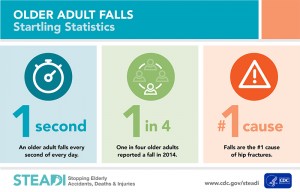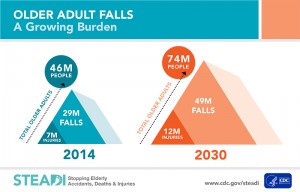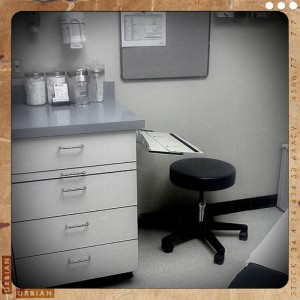
“A Doctor May Save Your Life, But An Occupational Therapist Helps You Live It.”
February 2016; easily the most gratifying month of my life. This is the month I received my occupational therapy assistant license and certification along with obtaining two jobs in the field. When I look back on this past year, I feel a huge sense of joy. I have mainly been working with geriatric patients. This population holds a special place in my heart for various reasons. First and foremost, no two clients are the same, they are fascinating to speak with and learn from! My days are filled with education and assisting my patients obtain independence in their daily occupations through therapeutic activities. Occupational therapy views our client’s holistically. We look at everything that encompasses the individual and help them return to their daily occupations and regain independence.
It never ceases to amaze me how often I educate my clients on fall prevention.
Throughout this time period, I have had a surplus of conversations with my clients prior to discharge, regarding the set up of their living environments. This is a critical conversation prior to someone returning home. The age range in this type of facility varies, from as young as 37 upwards to 100.
MYTH: Only people over 80 are at risk for falls.
FACT: Falls can happen to ANYONE! Disease, Diagnoses, and Disability Do Not Discriminate.
FACT: All of these things in combination with your home environment can put you at risk for a fall.
Who Is At Risk?
According to the CDC, Centers For Disease Control and Prevention (CDC, 2016) state that those who have multiple risk factors are more likely to experience a fall. These “risk factors” can be modifiable or intrinsic to the individual. Modifiable is what medical professionals aim to address in annual physical appointments, occupational or physical therapy, and or home care. Intrinsic is what is internal to the individual. Something that is either non-modifiable or highly unlikely to change.
Modifiable risk factors include:
- Lower body weakness
- Difficulties with gait and balance
- Use of psychoactive medications
- Poor vision
- Problems with feet and or shoes
- Home hazards; cluttered hallways, cables left on floor, loose rugs
Intrinsic risk factors include:
- Advanced age
- Postural hypotension
- Previous falls
- Fear of falling
- Chronic conditions; Parkinson’s, stroke, incontinence, dementia, diabetes, arthritis

Preserve Your Independence- In 3 Easy Steps
Below are some suggestions for how to take action and reduce your risk of falls.
1. Annual Doctor’s Visit: Most individuals have an appointment with their primary care physician yearly. This is your time to ACT and SPEAK UP! Your provider will review your current medications and health status. Afterwards, ask them about potential side effects of your medications, community health exercise programs and resources. This is a great first step in reducing modifiable risk factors!
2. In Your Home: Take a look around on the floors, hallways, bathroom, stairs… And ask your self these questions.
- Do you have things piling up in hallways or in bedrooms?
- Are your rugs loose?
- Are there electric cables lining areas you frequently walk through?
- Is there adequate lighting in each room of the house?
- Do you have items on your stairs?
- Are any of your stairs damaged or loose?
- Are your stairs lined with carpet?
- Are there handrails to your stairs?
- Do you frequently reach into cabinets at an elevated height?
- Is your bathroom tub or shower slippery?
- Do you frequently wear slip on shoes or walk barefoot?
If you answered YES to any of the questions, you are putting yourself at risk for a fall!
Occupational Therapist’s frequently perform home visits prior to a person’s discharge from the therapy. Often, they ask similar questions to the individual, observe the home environment and then make suggestions for safer living. Our goal is to ensure safety amongst our client’s when they are performing meaningful occupations. The above situations can be remedied through simple solutions and adaptations within your home.
Suggestions For A Safer Living Environment
- Clear hallways and stairs of ANY clutter, cables or belongings
- Utilize night lights, have adequate lighting in dark areas of your home
- Secure or dispose of throw rugs
- Secure handrails
- Place items at waist height to limit excessive reaching into high cabinets/closets
- Place a skid bath mat in your tub or shower (These can be found at Dollar Tree!)
- When you’re walking in your home, always wear closed back shoes…slip ons can slip off!
The video below goes into further detail about tips for preventing falls and is consistent with the suggestions listed above.
3. In The Community: Senior centers, local gyms, YMCA’S offer various exercise and physical fitness classes and memberships. It is important to maintain health and wellness through engaging in physical activity. Keeping our bodies strong is essential to safe mobility and balance.

Incidence of Falls
When we look at “incidence” of falls throughout the general population, we are describing the number of new cases in a given year. This blog thus far has provided facts to combat the myths about falls in our society. There is a larger risk amongst adults and seniors with multiple risk factors. However, they can still occur with younger adults with similar risk factors.
It is important to understand that there are modifiable factors that can reduce your chance of falling in your home. The purpose of this blog was to illustrate the facts behind the rising incidence of falls in the general population.

This graphic illustrates the reality behind the growing incidence of falls in our society. If more measures are taken by individuals and by professionals it is possible to reduce this rising number.
For Providers
https://www.youtube.com/watch?v=6GdMN0Yp7EQ&index=1&list=PLWqeMoseZ2MwwznjB-TFrq4dtHX8hPsSE
This video is an excellent resource for professionals who are looking to incorporate fall prevention into their current practice. This video is from the CDC, centers for disease control and prevention, a government website that created the STEADI program. STEADI stands for stopping elderly accidents death and injuries and provides information for what professionals can do in practice.
References:
https://www.cdc.gov (n.d.)
http://www.aota.org (n.d.)
http://www.ottoolkit.com/about (n.d.)
http://www.clipartkid.com/elderly-fall-prevention-cliparts/ (n.d.)

